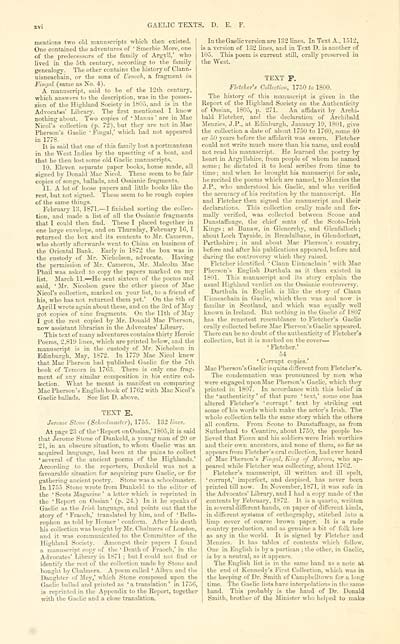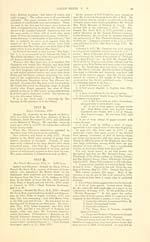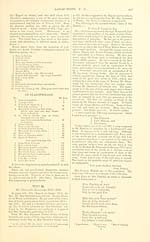Download files
Complete book:
Individual page:
Thumbnail gallery: Grid view | List view

GAELIC TEXTS. D. E. F.
mentions t-svo old manuscripts wticli then existed.
One contained the adventures of ' Smerbie More, one
of the predecessors of the family of Argyll,' who
lived in the 5th century, according to the family
genealogy. The other contains the history of Clann-
nisneachain, or the sons of Us7wch, a fragment in
Fingal (same as Ko. 4).
A manuscript, said to be of the 12th century,
which answers to the description, was in the posses-
sion of the Highland Society in 1805, and is in the
Advocates' Library. The first mentioned I_ know
nothing about. Two copies of ' llanus ' are in Mac
Nicol's collection (p. 72), but they are not in Mac
Pherson's Gaelic ' Fingal,' which had not appeared
in 1778.
It is said that one of this family lost a portmanteau
in the West Indies by the upsetting of a boat, and
that he then lost some old Gaelic manuscripts.
10. Eleven separate paper books, home made, all
signed by Donald Mac Nicol. These seem to be fair
copies of songs, ballads, and Ossianic fragments.
11. A lot of loose papers and little books like the
rest, but not signed. These seem to be rough copies
of the same things.
February 13, 1871. — I finished sorting the collec-
tion, and made a list of all the Ossianic fragments
that I could then find. These I placed together in
one large envelope, and on Thui-sday, February 16, I
returned tlie box and its contents to Mr. Cameron,
who shortly afterwards went to China on business of
the Oriental Bank. Early in 1872 the box was in
the custody of Mr. Nicholson, advocate. Ha-s-ing
the permission of Mr. Cameron, ilr. ilalcolm Mac
Phail was asked to copy the papers marked on my
list. March 11. — He sent sixteen of the poems and
said, ' Mr. Nicolson gave the other pieces of Mac
Nicol's collection, marked on your list, to a friend of
his, who has not returned them yet.' On the 8th of
Aprill wrote again about these, and on the 3rd of May
got copies of nine fragments. On the 11th of Maj'
I got the rest copied by ISIr. Donald Mac Pherson,
now assistant librarian in the Advocates' Library.
This text of many adventures contains thirty Heroic
Poems, 2,819 lines, which are printed below, and the
manuscript is in the custody of Mr. Nicholson in
Edinburgh, May, 1872. In 1779 Mac Nicol knew
that Mac Pherson had published Gaelic for the 7th
book of Temora in 1763. There is only one frag-
ment of any similar composition in his entire col-
lection. What he meant is manifest on comparing
Mac Pherson's English book of 1762 mth Mac Nicol's
Gaelic ballads. See list D. above.
TEXT E.
Jerome Stanc (ScJioolmaster), 1755. 132 Jines.
At page 23 of the'Eeport onOssian,'lS05,it is said
that Jerome Stone of Dunkeld, a young man of 20 or
21, in an obscure situation, to whom Gaelic was an
acquired language, had been at the pains to collect
' several of the ancient poems of the Highlands.'
According to the reporters, Dunkeld was not a
favourable situation for acquiring pure Gaelic, or for
gathering ancient poetry. Stone was a schoolmaster.
In 1755 Stone wrote from Dunkeld to the editor of
the ' Scots Magazine ' a letter wliich is reprinted in
the ' Report on Ossian ' (p. 24.) In it he speaks of
Gaelic as the Irish language, and points out that the
story of ' Fraoch,' translated by him, and of ' Belle-
rophon as told by Homer ' conform. After his death
his collection was bought by Mr. Chalmers of London,
and it was communicated to the Committee of the
Highland Society. Amongst their papers I found
a manuscript copy of the ' Death of Fraoch,' in the
Advocates' Library in 1871 ; but I could not find or
identify the rest of the collection made by Stone and
bought by Chalmers. A poem called ' Albyn and the
Daughter of Mey,' which Stone composed upon the
Gaelic ballad and printed as ' a translation' in 175G,
is reprinted in the Appendix to the Report, together
with the Gaelic and a close translation.
In the Gaelic version are 132 lines. In Text A., 1512,
is a version of 132 lines, and in Text D. is another of
105. This poem is current still, orally preserved in
the West.
TEXT P.
Fletcher's Collection, 1750 to 1800.
The history of this manuscript is given in the
Report of the Highland Society on the Authenticity
of Ossian, 1805, p. 271. An aflfidavit by Archi-
bald Fletcher, and the declaration of Archibald
Menzies, J.P., at Edinburgh, January 19, 1801, give
the collection a date of about 1750 to 1760, some 40
or 50 years before the affidavit was sworn. Fletcher
could not write much more than his name, and could
not read his manuscript. He learned the poetry by
heart in Argyllshire, from people of whom he named
some ; he dictated it to local scribes from time to
time ; and when he brought his manuscript for sale,
he recited the poems which are named, to Menzies the
J.P., who understood his Gaelic, and who verified
the accuracy of his recitation by the manuscript. He
and Fletcher then signed the manuscript and their
declarations. This collection orally made and for-
mally verified, was collected between Scone and
Dunstafiiiage, the chief seats of the Scoto-Irish
Kings ; at Bunaw, in Glenorchy, and Glenfalloch ;
about Loch Tayside, in Breadalbane, in Glendochart,
Perthshire ; in and about jSIac Pherson's country,
before and after his publications appeared, before and
during the controversy which they raised.
Fletcher identified ' Clann Uisneachain ' with Mac
Pherson's English Darthula as it then existed in
1801. This manuscript and its story explain the
usual Highland verdict on the Ossianic controversy.
Darthula in English is like the story of Clann
Uisneachain in Gtielic, which then was and now is
familar in Scotland, and which was equally weU
known in Ireland. But nothing in the Gaelic of 1807
has the remotest resemblance to Fletcher's Gaelic
orally collected before ]\Iac Pherson's Gaeho appeared.
There can be no doubt of the authenticity of Fletcher's
collection, but it is marked on the cover —
' Fletcher.'
54
' Corrupt copies.'
Mac Pherson's Gaelic isquite different from Fletcher's.
The condemnation was pronounced by men who
were engaged uponMac Pherson's Gnehc, which they
printed in 1807. In accordance vN-ith this behef in
the ' authenticity ' of that pure ' text, ' some one has
altered Fletcher's ' corrupt ' text by striking out
some of his words which make the actor's Irish. The
whole collection tells the same story which the others
all confirm. From Scone to DunstafiTnage, as from
Sutherland to Ceantire, about 1750, the people be-
lieved that Fionn and his soldiers were Irish worthies
and their own ancestors, and none of them, so far as
appears from Fletcher's oral collection, had ever heard
of Mac Pherson's Fingal, King of Morren, who ap-
peared while Fletcher was collecting, about 1762.
Fletcher's manuscript, ill written and ill spelt,
' corrupt,' imperfect, and despised, has never been
printed till now. In November, 1871, it was safe in
the Advocates' Library, and I had a copy made of the
contents by February, 1872. It is a quarto, written
in several different hands, on paper of different kinds,
in different systems of orthography, stitched into a
limp cover of coarse brown paper. It is a rude
country production, and as genuine a bit of folk lore
as any in the world. It is signed by Fletcher and
Menzies. It has tables of contents which follow.
One in English is by a partisan ; the other, in Gaelic,
is by a neutral, as it appears.
The English list is in the same hand as a note at
the end of Kennedy's First Collection, which was in
the keeping of Dr. Smith of Campbelltown for a long
time. The Gaelic lists have interpolations in the same
hand. This probably is the hand of Dr. Donald
Smith, brother of the Minister who helped to make
mentions t-svo old manuscripts wticli then existed.
One contained the adventures of ' Smerbie More, one
of the predecessors of the family of Argyll,' who
lived in the 5th century, according to the family
genealogy. The other contains the history of Clann-
nisneachain, or the sons of Us7wch, a fragment in
Fingal (same as Ko. 4).
A manuscript, said to be of the 12th century,
which answers to the description, was in the posses-
sion of the Highland Society in 1805, and is in the
Advocates' Library. The first mentioned I_ know
nothing about. Two copies of ' llanus ' are in Mac
Nicol's collection (p. 72), but they are not in Mac
Pherson's Gaelic ' Fingal,' which had not appeared
in 1778.
It is said that one of this family lost a portmanteau
in the West Indies by the upsetting of a boat, and
that he then lost some old Gaelic manuscripts.
10. Eleven separate paper books, home made, all
signed by Donald Mac Nicol. These seem to be fair
copies of songs, ballads, and Ossianic fragments.
11. A lot of loose papers and little books like the
rest, but not signed. These seem to be rough copies
of the same things.
February 13, 1871. — I finished sorting the collec-
tion, and made a list of all the Ossianic fragments
that I could then find. These I placed together in
one large envelope, and on Thui-sday, February 16, I
returned tlie box and its contents to Mr. Cameron,
who shortly afterwards went to China on business of
the Oriental Bank. Early in 1872 the box was in
the custody of Mr. Nicholson, advocate. Ha-s-ing
the permission of Mr. Cameron, ilr. ilalcolm Mac
Phail was asked to copy the papers marked on my
list. March 11. — He sent sixteen of the poems and
said, ' Mr. Nicolson gave the other pieces of Mac
Nicol's collection, marked on your list, to a friend of
his, who has not returned them yet.' On the 8th of
Aprill wrote again about these, and on the 3rd of May
got copies of nine fragments. On the 11th of Maj'
I got the rest copied by ISIr. Donald Mac Pherson,
now assistant librarian in the Advocates' Library.
This text of many adventures contains thirty Heroic
Poems, 2,819 lines, which are printed below, and the
manuscript is in the custody of Mr. Nicholson in
Edinburgh, May, 1872. In 1779 Mac Nicol knew
that Mac Pherson had published Gaelic for the 7th
book of Temora in 1763. There is only one frag-
ment of any similar composition in his entire col-
lection. What he meant is manifest on comparing
Mac Pherson's English book of 1762 mth Mac Nicol's
Gaelic ballads. See list D. above.
TEXT E.
Jerome Stanc (ScJioolmaster), 1755. 132 Jines.
At page 23 of the'Eeport onOssian,'lS05,it is said
that Jerome Stone of Dunkeld, a young man of 20 or
21, in an obscure situation, to whom Gaelic was an
acquired language, had been at the pains to collect
' several of the ancient poems of the Highlands.'
According to the reporters, Dunkeld was not a
favourable situation for acquiring pure Gaelic, or for
gathering ancient poetry. Stone was a schoolmaster.
In 1755 Stone wrote from Dunkeld to the editor of
the ' Scots Magazine ' a letter wliich is reprinted in
the ' Report on Ossian ' (p. 24.) In it he speaks of
Gaelic as the Irish language, and points out that the
story of ' Fraoch,' translated by him, and of ' Belle-
rophon as told by Homer ' conform. After his death
his collection was bought by Mr. Chalmers of London,
and it was communicated to the Committee of the
Highland Society. Amongst their papers I found
a manuscript copy of the ' Death of Fraoch,' in the
Advocates' Library in 1871 ; but I could not find or
identify the rest of the collection made by Stone and
bought by Chalmers. A poem called ' Albyn and the
Daughter of Mey,' which Stone composed upon the
Gaelic ballad and printed as ' a translation' in 175G,
is reprinted in the Appendix to the Report, together
with the Gaelic and a close translation.
In the Gaelic version are 132 lines. In Text A., 1512,
is a version of 132 lines, and in Text D. is another of
105. This poem is current still, orally preserved in
the West.
TEXT P.
Fletcher's Collection, 1750 to 1800.
The history of this manuscript is given in the
Report of the Highland Society on the Authenticity
of Ossian, 1805, p. 271. An aflfidavit by Archi-
bald Fletcher, and the declaration of Archibald
Menzies, J.P., at Edinburgh, January 19, 1801, give
the collection a date of about 1750 to 1760, some 40
or 50 years before the affidavit was sworn. Fletcher
could not write much more than his name, and could
not read his manuscript. He learned the poetry by
heart in Argyllshire, from people of whom he named
some ; he dictated it to local scribes from time to
time ; and when he brought his manuscript for sale,
he recited the poems which are named, to Menzies the
J.P., who understood his Gaelic, and who verified
the accuracy of his recitation by the manuscript. He
and Fletcher then signed the manuscript and their
declarations. This collection orally made and for-
mally verified, was collected between Scone and
Dunstafiiiage, the chief seats of the Scoto-Irish
Kings ; at Bunaw, in Glenorchy, and Glenfalloch ;
about Loch Tayside, in Breadalbane, in Glendochart,
Perthshire ; in and about jSIac Pherson's country,
before and after his publications appeared, before and
during the controversy which they raised.
Fletcher identified ' Clann Uisneachain ' with Mac
Pherson's English Darthula as it then existed in
1801. This manuscript and its story explain the
usual Highland verdict on the Ossianic controversy.
Darthula in English is like the story of Clann
Uisneachain in Gtielic, which then was and now is
familar in Scotland, and which was equally weU
known in Ireland. But nothing in the Gaelic of 1807
has the remotest resemblance to Fletcher's Gaelic
orally collected before ]\Iac Pherson's Gaeho appeared.
There can be no doubt of the authenticity of Fletcher's
collection, but it is marked on the cover —
' Fletcher.'
54
' Corrupt copies.'
Mac Pherson's Gaelic isquite different from Fletcher's.
The condemnation was pronounced by men who
were engaged uponMac Pherson's Gnehc, which they
printed in 1807. In accordance vN-ith this behef in
the ' authenticity ' of that pure ' text, ' some one has
altered Fletcher's ' corrupt ' text by striking out
some of his words which make the actor's Irish. The
whole collection tells the same story which the others
all confirm. From Scone to DunstafiTnage, as from
Sutherland to Ceantire, about 1750, the people be-
lieved that Fionn and his soldiers were Irish worthies
and their own ancestors, and none of them, so far as
appears from Fletcher's oral collection, had ever heard
of Mac Pherson's Fingal, King of Morren, who ap-
peared while Fletcher was collecting, about 1762.
Fletcher's manuscript, ill written and ill spelt,
' corrupt,' imperfect, and despised, has never been
printed till now. In November, 1871, it was safe in
the Advocates' Library, and I had a copy made of the
contents by February, 1872. It is a quarto, written
in several different hands, on paper of different kinds,
in different systems of orthography, stitched into a
limp cover of coarse brown paper. It is a rude
country production, and as genuine a bit of folk lore
as any in the world. It is signed by Fletcher and
Menzies. It has tables of contents which follow.
One in English is by a partisan ; the other, in Gaelic,
is by a neutral, as it appears.
The English list is in the same hand as a note at
the end of Kennedy's First Collection, which was in
the keeping of Dr. Smith of Campbelltown for a long
time. The Gaelic lists have interpolations in the same
hand. This probably is the hand of Dr. Donald
Smith, brother of the Minister who helped to make
Set display mode to: Large image | Transcription
Images and transcriptions on this page, including medium image downloads, may be used under the Creative Commons Attribution 4.0 International Licence unless otherwise stated. ![]()
| Early Gaelic Book Collections > Ossian Collection > Leabhar na Feinne > (20) |
|---|
| Permanent URL | https://digital.nls.uk/80030161 |
|---|
| Description | Selected books from the Ossian Collection of 327 volumes, originally assembled by J. Norman Methven of Perth. Different editions and translations of James MacPherson's epic poem 'Ossian', some with a map of the 'Kingdom of Connor'. Also secondary material relating to Ossianic poetry and the Ossian controversy. |
|---|
| Description | Selected items from five 'Special and Named Printed Collections'. Includes books in Gaelic and other Celtic languages, works about the Gaels, their languages, literature, culture and history. |
|---|

